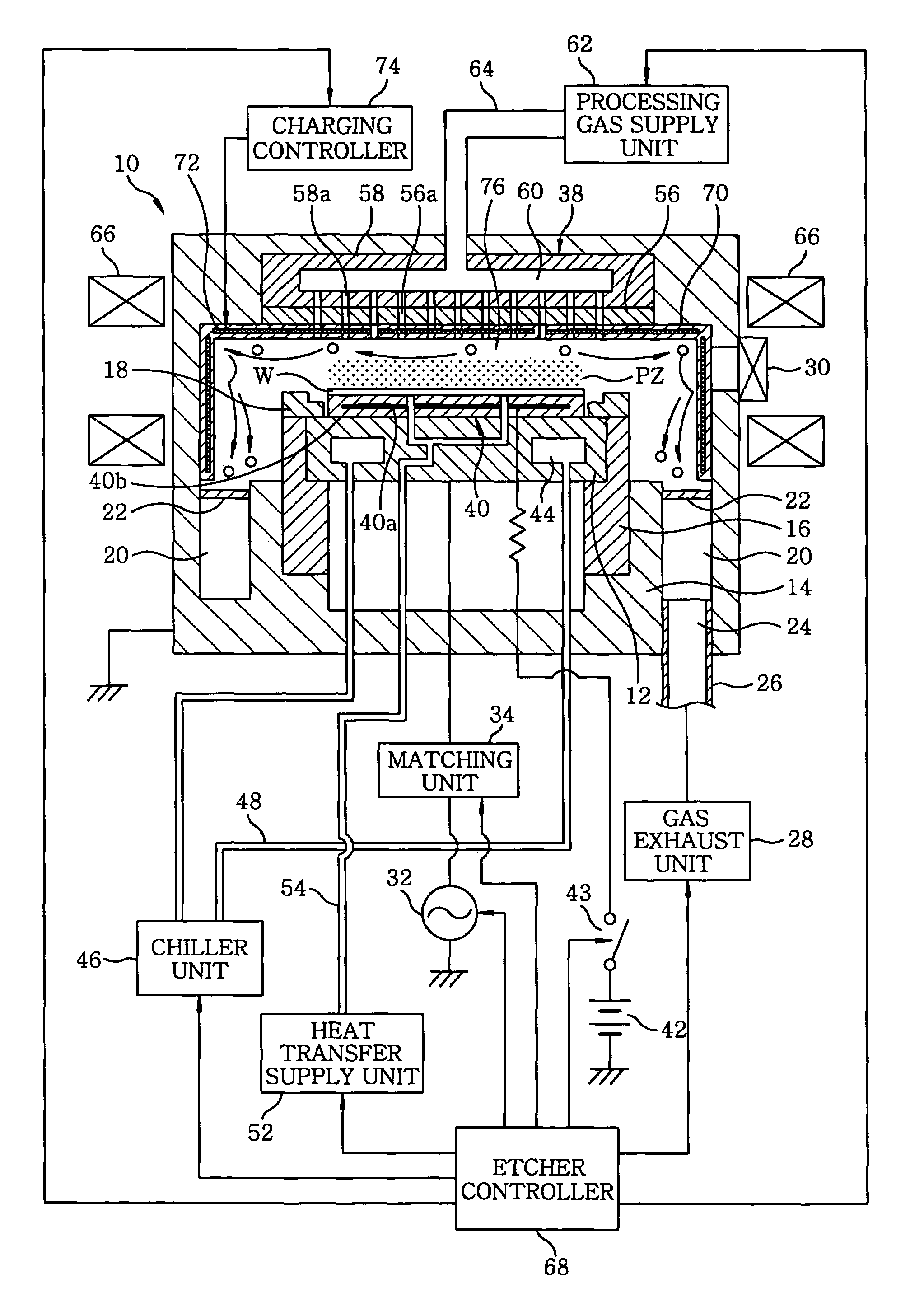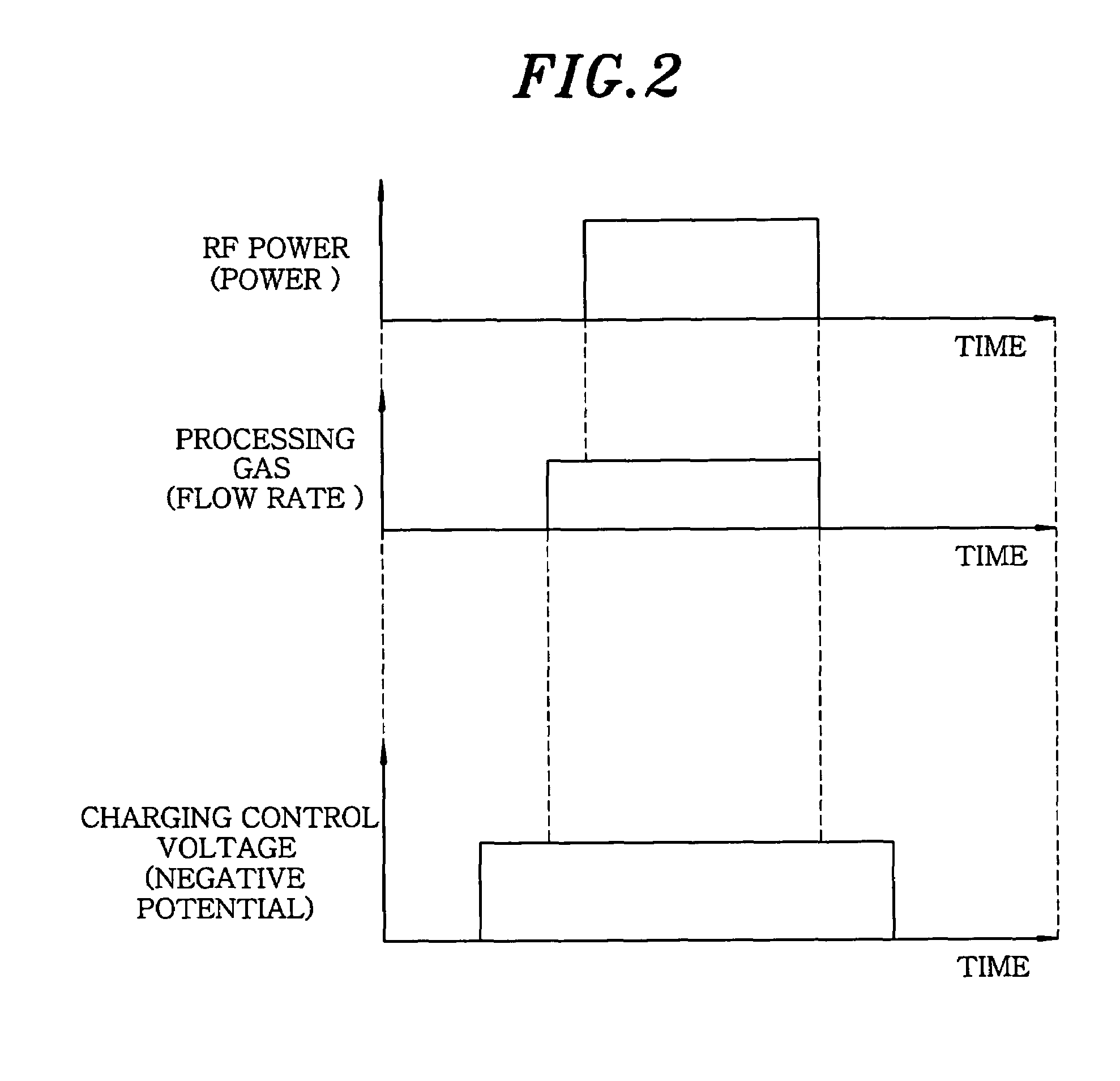Particle removal apparatus and method and plasma processing apparatus
a technology of plasma processing apparatus and particle removal, which is applied in the field of particle removal apparatus and method and plasma processing apparatus, can solve the problems of plasma disturbance, reduced production yield or deterioration of the operating rate of the processing apparatus, and inability to remove electrically neutral or negatively charged particles
- Summary
- Abstract
- Description
- Claims
- Application Information
AI Technical Summary
Benefits of technology
Problems solved by technology
Method used
Image
Examples
second embodiment
[0070]FIG. 9 shows a configuration of a plasma etching apparatus having a particle removal apparatus in accordance with a second preferred embodiment of the present invention. In the drawing, like reference numerals will be assigned to like parts having substantially same configurations or functions, and redundant description thereof will be omitted in the specification and the accompanying drawings. Here, a characteristic feature of the second preferred embodiment will be discussed mainly. In the second preferred embodiment, a member for performing a drift transfer on a positively charged particle in a particle charging region 76, same as in the aforementioned first embodiment, is included, so that a particle can be discharged outside the chamber further efficiently.
[0071]As shown in FIG. 9, a first charging electrode 102 embedded in a film-shaped insulator 100 is installed in an inner wall of the ceiling of a chamber 10 containing the inner wall surface of an electrode plate 56 of...
third embodiment
[0075]FIG. 11 shows a configuration of a plasma etching apparatus having a particle removal apparatus in accordance with a third preferred embodiment of the present invention. In the drawing, the same reference numerals with those of the first and the second embodiment (FIGS. 1 and 9) will be assigned to like parts having substantially same configurations or functions, and redundant description thereof will be omitted in the specification and the accompanying drawings. Here, a characteristic feature of the third preferred embodiment will be discussed mainly. In the third embodiment, means or a method for more forcibly transferring or delivering the particles charged positively in a particle charging region 76 is included, so that the particles can be discharged outside a chamber 10 more efficiently, as compared with the second embodiment.
[0076]As shown in FIG. 11, an upper charging electrode 102 is divided into a central charging electrode 102A and a peripheral charging electrode 10...
fourth embodiment
[0083]FIG. 13 shows a configuration of an apparatus in accordance with a fourth embodiment. The fourth embodiment is same as the third one, except that two characteristic features are added. The first characteristic feature is that a DC positive voltage is applied to a substrate W side (e.g., the electrode 40a of an electrostatic chuck 40) to thereby repel a positively charged particle therefrom in order to prevent the falling of the positively charge particle onto a substrate W to be processed. For this, a variable output voltage DC power source 114 is electrically connected to an electrostatic chuck electrode 40a on a susceptor 12, via a low-pass filter 116. Here, the low-pass filter 116 functions to cut off a high frequency from a high frequency power source 32.
[0084]A second characteristic feature is that the particle removing is facilitated by applying a negative voltage to a baffle plate 22 disposed in an opening of a gas exhaust path 20 in a bottom part of a chamber 10. In FI...
PUM
| Property | Measurement | Unit |
|---|---|---|
| frequency | aaaaa | aaaaa |
| current | aaaaa | aaaaa |
| electric potential | aaaaa | aaaaa |
Abstract
Description
Claims
Application Information
 Login to View More
Login to View More - R&D
- Intellectual Property
- Life Sciences
- Materials
- Tech Scout
- Unparalleled Data Quality
- Higher Quality Content
- 60% Fewer Hallucinations
Browse by: Latest US Patents, China's latest patents, Technical Efficacy Thesaurus, Application Domain, Technology Topic, Popular Technical Reports.
© 2025 PatSnap. All rights reserved.Legal|Privacy policy|Modern Slavery Act Transparency Statement|Sitemap|About US| Contact US: help@patsnap.com



